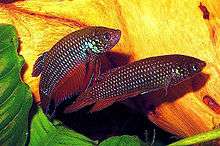Betta smaragdina
Betta smaragdina, the emerald green betta, blue betta or Mekong fighting fish, Thai: ปลากัดเขียว or ปลากัดอีสาน is a species of betta fish native to Thailand and Laos, where they are found in the basins of the Mekong, Chao Phraya river mostly found at mun and Chi rivers in Isan region, Thailand. This species grows to a length of 7 cm (2.8 in). They get their green and blue colors due to refraction and interference of light that come from hexagonal crystals that are less than .3 to .5 miera.[2] This species is also found in the aquarium trade.[3]
| Betta smaragdina | |
|---|---|
 | |
| Scientific classification | |
| Kingdom: | Animalia |
| Phylum: | Chordata |
| Class: | Actinopterygii |
| Order: | Anabantiformes |
| Family: | Osphronemidae |
| Genus: | Betta |
| Species: | B. smaragdina |
| Binomial name | |
| Betta smaragdina Ladiges, 1972 | |
Description
Size: 1.75 - 2 inches long. [4]
Distribution
Cambodia, Lao People's Democratic Republic, and Thailand. [5]
Habitat
B. Smaragdina lives in still or sluggish bodies of water. This includes rice paddies, swamps, roadside ditches, streams and ponds. These are usually shaded by much vegetation. The substrate can be leaf litter, mud, or sand. [6]
Conservation status
Betta smaragdina is listed as data dificient by the IUCN
This species is uncommon throughout its range and the population is still decreasing. It is threatened by habitat destruction, pollution, and hybridization with escaped domesticated Bettas. [7]
Diet
Eats terrestrial and aquatic invertebrates in the wild. In captivity they can be fed live or frozen food like Daphnia, Artemia or bloodworms. [8]
Breeding
Males will build a bubble nest before breeding. The temperature should be 78-80ºF. Males and females can live together and the male and female should already live together for breeding. When the female is interested in mating she becomes lighter coloured and develops vertical bars. After mating the male catches the falling eggs and places them in his bubble nest. In 1-2 days the eggs hatch and continue absorb their yolk sack for 3-4 days. In 4-5 days the fry become free swimming. Until this the male cares for them. [9]
In the aquarium
In the aquarium This species is often kept by Betta hobbyists but is rarely available in the aquarium trade. [10]
The Siamese fighting fish is actually a hybrid of multiple species in the B. Splendens complex including Betta smaragdina. [11]
The "Alien" hybrid Betta fish is a hybrid of the wild versions of Bettas in the B. Splendens complex including B. Smaragdina. [12]
Gallery
 A male
A male A pair
A pair
References
- Vidthayanon, C. (2012). "Betta smaragdina". IUCN Red List of Threatened Species. 2012: e.T180827A1666967. doi:10.2305/IUCN.UK.2012-1.RLTS.T180827A1666967.en.
- Goodrich, H. B.; Mercer, Rowena N. (1934). "Genetics and Colors of the Siamese Fighting Fish, Betta Splendens". Science. 79 (2049): 318–319. Bibcode:1934Sci....79..318G. doi:10.1126/science.79.2049.318. ISSN 0036-8075. JSTOR 1658774. PMID 17738688.
- Froese, Rainer and Pauly, Daniel, eds. (2014). "Betta smaragdina" in FishBase. February 2014 version.
External links
